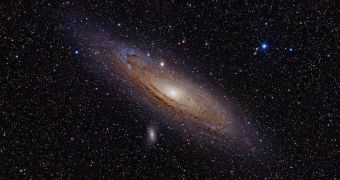Studies conducted in late 2009, using the NASA Chandra X-ray Observatory, revealed the existence of what astrophysicists referred to as an ultraluminous source of intense radiations in our neighbor, the Andromeda Galaxy. A new investigation confirms the object is indeed a black hole.
This was experts' first guess, but they had no way of being sure that that was the case until they conducted an in-depth investigation. The work reveals that the object, codenamed ULX, is in fact an insatiable dark behemoth gobbling up vast volumes of matter from its surroundings.
It lies within the Andromeda Galaxy, which is located about 2.5 million light-years from Earth, and represents a unique target for study due to its proximity. Scientists have already established that the reason why it's so bright is because it's eating a lot.
Black holes are usually surrounded by formations called accretion disks, which is where the matter that will fall through the event horizon first gathers. Intense friction within the disks heats it to millions of degrees, leading to the release of impressive volumes of radiations.
Ground-based and orbital telescopes can easily pick up such bright wavelengths. Determining what produced them is a bit trickier, since black holes cannot be confirmed directly. Scientists have to conduct indirect measurements to establish what the X-ray sources are.
The Andromeda-based object is the first, brightest and closest ULX ever found, so multiple research teams are currently investigating it. According to investigators, the object is a stellar-mass black hole, only 13 times more massive than the Sun.
“ULX sources are still pretty exotic. But our work shows that at least some are linked to the normal black holes left behind after the death of massive stars, objects that are found throughout the Universe, and the way that they drag in surrounding material,” scientist Matt Middleton explains.
“The ULX in Andromeda flared up because of the black hole's voracious appetite for new material,” adds the expert, who was the leader of the investigation. He holds an appointment as a research associate with the Durham University Department of Physics.
Details of the research were published in two scientific papers, one appearing in Astronomy and Astrophysics and the other in Monthly Notices of the Royal Astronomical Society, Space reports.

 14 DAY TRIAL //
14 DAY TRIAL //